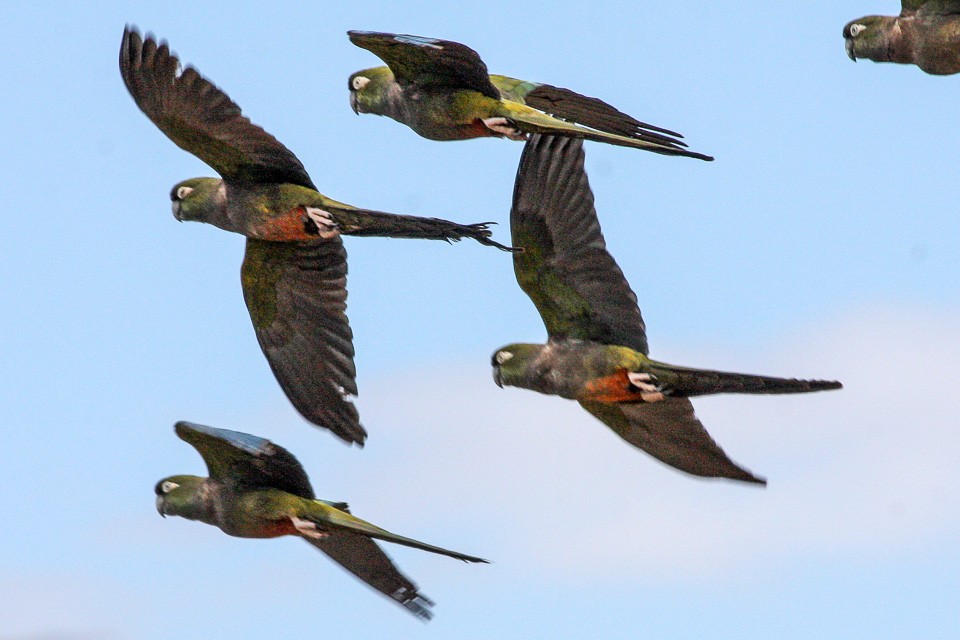Burrowing Parakeet
A species of Burrowing Parrot, Also known as Patagonian Conure Scientific name : Cyanoliseus patagonus Genus : Burrowing Parrot
Burrowing Parakeet, A species of Burrowing Parrot
Also known as:
Patagonian Conure
Botanical name: Cyanoliseus patagonus
Genus: Burrowing Parrot
Content
Description People often ask General Info
Description
Adults measure 39–52 cm in length, with a wingspan of 23–25 cm and a long, graduated tail that can range from 21 to 26 cm. Burrowing parrots are slightly sexually dimorphic, with males being slightly larger and weighing approximately 253-340 g, while females weigh 227-304 g, making it the largest member of the group of New World parakeet species commonly known as conures. The burrowing parrot is a distinctive parrot; it has a bare, white eye ring and post-ocular patch, its head and upper back are olive-brown, and its throat and breast are grey-brown with a whitish pectoral marking, which is variable and rarely extends across the whole breast. The lower thighs and the center of the abdomen are orange-red, and it is thought that the extent and hue of the red plumage indicates the quality of the individual as a breeding partner and parent. The lower back, upper thighs, rump, vent and flanks are yellow, and the wing coverts olive green. The tail is olive green with a blue caste when viewed from above and brown from below. The burrowing parrot has a grey bill and yellow-white iris with pink legs. Immature birds look like adults but with a horn coloured upper mandible patch and a pale grey iris. While both sexes look visually similar to the human eye, the burrowing parrot is sexually dichromatic. Males tend to have significantly redder and larger abdominal red patches, and both sexes look different under UV light, with males have brighter green feathers and females having brighter blue feathers. 
Size
52 cm
Colors
Black
Green
Yellow
Red
Gray
White
Blue
Orange
Life Expectancy
19.5-34.1 years
Nest Placement
Burrow
Feeding Habits
Burrowing Parakeet consumes a varied diet including seeds, berries, fruits, and vegetables, foraging on the ground and in flora. Diet changes seasonally with fruits peaking in Argentina's summer. Unique preferences include red crowberry, Chilean palo verde, and various cacti. In winter, burrowing Parakeet mainly eats seeds from crops and wild plants.
Habitat
Burrowing Parakeet predominantly inhabits arid and semiarid landscapes, often near watercourses. Their preferred terrain spans montane shrublands, Patagonian steppes, and the arid Gran Chaco plains, occasionally adapting to human-modified areas. Typically found at elevations up to 2000 meters, they thrive in open country with sandy soils conducive to their burrowing. Vegetation in these areas includes Geoffroea decorticans and Prosopis species.
Dite type
Herbivorous
People often ask
General Info
Feeding Habits
Bird food type
Distribution Area
The burrowing parrot can be found in much of Argentina, and there are isolated populations in central Chile. In the winter, birds in central and southern Argentina may migrate north as far as southern Uruguay, making them austral migrants, while Chilean birds migrate vertically down slope to avoid colder altitudes. Movements in the populations of northwestern Argentina are also known to occur according to food availability. The burrowing parrot prefers dry, open country, particularly in the vicinity of water courses, up to 2000 m in elevation. Habitats include montane grassy shrubland, Patagonian steppes, arid lowland, woodland savanna, and the plains of the Gran Chaco. They may also inhabit farmland and the edges of urban areas. 
Species Status
Not globally threatened.
Scientific Classification
Phylum
Chordates Class
Birds Order
Parrots Family
Parrots Genus
Burrowing Parrot Species
Burrowing Parakeet 